Having recently reported (https://www.thefirearmblog.com/blog/2017/04/13/imbels-new-7-62x51mm-ia2-carbine-rifle/) on the official certification test program of Brazil’s IMBEL 7.62x51mm IA2 semi-auto carbine currently under way at the CAEx – Centro de Avaliação do Exército (Army Evaluation Center), in Rio de Janeiro, it might be proper to inform TFB readers on the status of the earlier 5.56x45mm model.
It took IMBEL – Indústria de Material Bélico do Brasil quite a while to reach its current position as a viable manufacturer of 5.56x45mm rifles and carbines since the State-owned company started its efforts at such back in mid-1983 (https://www.thefirearmblog.com/blog/2017/04/10/imbels-first-5-56x45mm-rifle-attempt/). However, as that rotary-bolt prototype model proved unfeasible to go ahead due to budgetary restrictions (too much R&D money required and not readily available to launch the program), the State-owned company decided to later proceed with an even more FAL-based gun, a measure to basically to cut down costs since that rifle of Belgian origin had been fully nationalized in Brazil back in 1973 as the M964 (fixed stock) and the M964A1 (foldable tubular stock), and was still in full-scale production at the Fábrica de Itajubá (Itajubá Factory), in Minas Gerais State. The earliest attempt along this path materialized as a selective-fire, tilted-bolt breech locking prototype designated MD1 in 1984-85, featuring the PARA-FAL model stock, a dedicated 20-round magazine, a short wooden handguard (pretty much the same as the one used in the FN FALO Squad Automatic Weapon), and an unprotected gas cylinder . Subsequent test models, however, took on the full-FAL look, mainly in the handguard department, and this resulted in the loaded weight almost touching the 5kg mark when a foldable bipod was fitted! Anyway, development work on the MD1 progressed, off-and-on, until end-1989 or so.

An early MD1 prototype with a short wooden handguard and unprotected gas tube. Note dedicated 20-round magazine, and FAL fold-flat cocking handle.

This later 5.56x45mm MD1 (rearward-folding bipod fitted) is shown alongside a 7.62x51mm PARA-FAL. Parts commonality is evident everywhere, flash hider and cylinder-type cocking piece included.

Another MD1/PARA-FAL comparative view.

The dedicated 20-round magazine distinguished the IMBEL MD1 from its 7.62x51mm M964A1 PARA-FAL (a.k.a. FN Model 50-63) originator.

The FAL 7.62x51mm and the MD1 5.56x45mm magazines, both with a 20-round capacity.

Twenty-round magazine being inserted into MD1 in a straight-up movement, while the FAL uses a hinged (front first) movement. Mag release lever is in the same position at the rear of housing. (Photo credit: Alexander Olive)
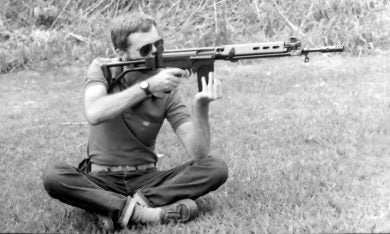
A hands-on day with the MD1 at IMBEL’s Fábrica de Itajubá in November, 1989. Can’t remember why the heck that firing position was used, maybe for the skinny operator to meditate and cope with the almost-5kg weight of the gun with 20-rounds in the magazine and the folded bipod fitted. (Photo credit: Alexander Olive)
The next progression step was achieved in the early 1990s with the MD2/MD2A1 (foldable stock, selective fire/semi-auto only) and MD3/MD3A1 models (fixed stock, selective fire/semi-auto only), but the initial market response made the FAL-type tubular folding stock the chosen one to go ahead with. Tests conducted by the Brazilian Army Campo de Provas da Marambaia (Marambaia Proving Grounds), in Rio de Janeiro, resulted in the official ReTEx No. 1364/91 certification being granted in January, 1991, thus clearing the gun for production and sales. Small batches of the MD2 were, in fact, delivered to selected Brazilian Army units for troop evaluation purposes, while the semi-auto MD2A1 found its way into the inventories of a number of state LE agencies, as in the case of Rio de Janeiro’s, which received 1,050 examples in 1995. As delivered, the rifles had a 453mm barrel, an overall length of 1030 mm (764mm, stock folded), and a loaded weight of 4.85kg with 30-rounds in the STANAG-compatible magazine that had, inevitably, replaced the earlier proprietary type. Yes, it was still too heavy.
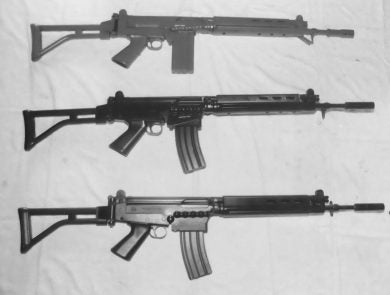
Photo shows evolution from the MD1 (top) with a proprietary magazine to the STANAG magazine-compatible MD2. Note different magazine housing configurations in the two weapons below.

A standard 7.62x51mm fixed-stock FAL and its 5.56x45mm foldable-stock IMBEL MD2A1 derivative.

An MD2A1 with a railed upper receiver cover and a Tasco Propoint red dot sight fitted. The sturdy FAL foldable bipod added to the barrel of this non-standard example made it about 500 grams (roughly one pound, American folks) heavier.

Author with the same rifle during a firing session pause in a Rio de Janeiro Military Police facility in October, 1995. Note the bipod folded flush with the handguard sides.
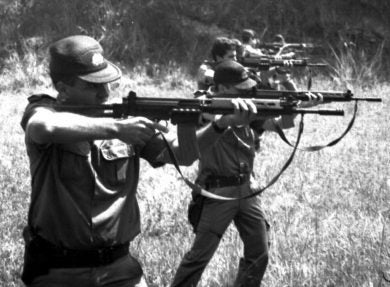
Some PMERJ (Rio de Janeiro State Military Police) troopers training with standard IMBEL M2A1s at the range in the mid-1990s.
In 1995, Brazilian Army’s Basic Operational Requirements No. 06/95 were issued in which new parameters for a 5.56x45mm rifle were set up, and this included a 3.8kg weight limit and a three-round burst facility. By a lucky coincidence, a young, enthusiastic Army engineering officer, Captain Paulo Augusto Capetti Porto, joined IMBEL that same year, and some of his ideas began to take shape. They resulted in the so-called MD97 family, which include ed the MD97L selective-fire rifle and the MD97LC semi-auto carbine. The man design improvement in the “97” series was replacing the FAL-type tilting bolt with a rotary bolt whose radial lugs locked directly to a barrel extension rather than to the somewhat redesigned lower receiver. This permitted the use of light alloy material in its construction and, so, some weight saving was achieved. The MD97LC carbine weight came down to a more reasonable (still, not ideal) 3.3kg empty, while the longer-barrel MD97L was 0.3kg heavier. Characteristic FAL components, of course, were still found here and there, including the pistol grip/trigger assembly, the foldable stock, and the handguard (shortened, in the LC carbine). Picatinny rails began to find their way to the top cover of the gun’s receiver, some in full-length and most in the shape of two in-line short units. The Brazilian Army did receive small batches of the MD97L rifle for field trials and general evaluation purposes, but main sales were those to a number of state LE agencies and to the Força Nacional de Segurança Pública (National Public Security Force), a Federal-controlled organization that is available to send troops to wherever in Brazil a local crisis requires extra police action.

The semi-auto MD97LC carbine (330mm barrel) was supplied in large numbers to state and federal LE agencies, while the selective-fire MD97L rifle (437mm barrel) had small batches delivered to the Brazilian Army for field evaluation, only.

An MD97LC carbine fitted with a Tasco Propoint red-dot sight mounted on two short Picatinny rails. Weapons delivered to local LE agencies, however, did not use this smart-looking pixelized camo finish.

This MD97LC is seen in Rio de Janeiro street combat use by a PFC (Private First-Class) soldier of 16 BPM (16th Military Police Battalion). The two short Picatinny rails are perceptible, as well as the weapon’s external signs of constant use.
It was only in 2008-2009, however, that IMBEL was able to seriously commit itself to a full development effort of a 5.56x45mm rifle by adequately investing in personnel qualification and modernization of its production equipment. Emphasis was also placed on establishing comprehensive in-house test facilities, including environmental (sand, mud, water, ice/cold weather) conditions, so that a rifle would come out able to, at the very long last, meet Brazilian Army’s Basic Operational Requirements and, a later state, Ministry of Defense’s Joint Operational Requirements.
In mid-2010, some prototype photos and computer-generated images began to appear of the officially-called Fuzil de Assalto (Assault Rifle) 5.56mm IA2, while the official public presentation of pre-production examples took place during the 2011 LAAD Defense Exhibition in Rio de Janeiro, in April of that year. In 2012, extensive demonstrations of a semi-auto-only version (called a “carbine”, but with the same barrel length of the rifle’s) for the local LE community began to take place in different parts of Brazil. On October 23, 2013, the Army issued Document No.211-EME announcing the official adoption of the selective-fire rifle as a complement to the 7.62x51mm M964 FAL.

First computer images of IMBEL’s 5.56x45mm IA2 rifle.

Early IA2 prototype with a longer (than the adopted 330mm) barrel and initial foldable stock configuration.

The IMBEL Fuzil de Assalto 5.56 IA2 as delivered to the Brazilian Army sports the green color in its polymer parts.

Brazilian Army troops armed with IA2 rifles on patrol duties in Rio de Janeiro during the 2016 Olympic Games.
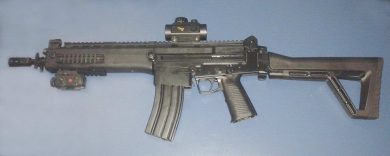
The semi-auto-only IA2 carbine as initially supplied to LE agencies in Brazil in this all-black finish.
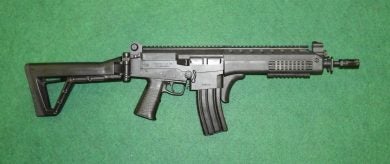
This IA2 carbine shows that a grip unit has been standardized in the gun just ahead of the magazine housing so that operators who may wish to do so have a better place for the support hand closer to the pistol grip.

This IA2 selective-fire rifle also shows the now-standard grip near the magazine and an optional length-adjustable folding stock.
As of this time, the approximate total number of 5.56x45mm IA2 rifles and carbines that have been delivered to the Brazilian Armed Forces and to LE/penitentiary agencies is 14,350 distributed as (also roughly) 6,450 for the military, 3,500 for state police agencies, and 4,390 for the Ministry of Justice (SENASP – National Public Security Secretary and DEPEN – National Penitentiary Department). Adoption by additional state police agencies that have demonstrated intention to do so has been slowed down due to the country’s current internal economic crisis, but IMBEL is ready to increase production rates as soon as the market demands. So far, official adoption by the local military is limited to the Army, but the Brazilian Navy is known to have asked IMBEL to add a number of modifications to the gun (prototypes believed to be ready) so that it better suits the requirements of Brazil’s Corpo de Fuzileiros Navais (Marine Corps). This shows a more than casual interest in the weapon and the possibility that it may eventually complement and/or replace that service’s M16A2 rifles and M4 carbines in service since 1996.
 Your Privacy Choices
Your Privacy Choices
